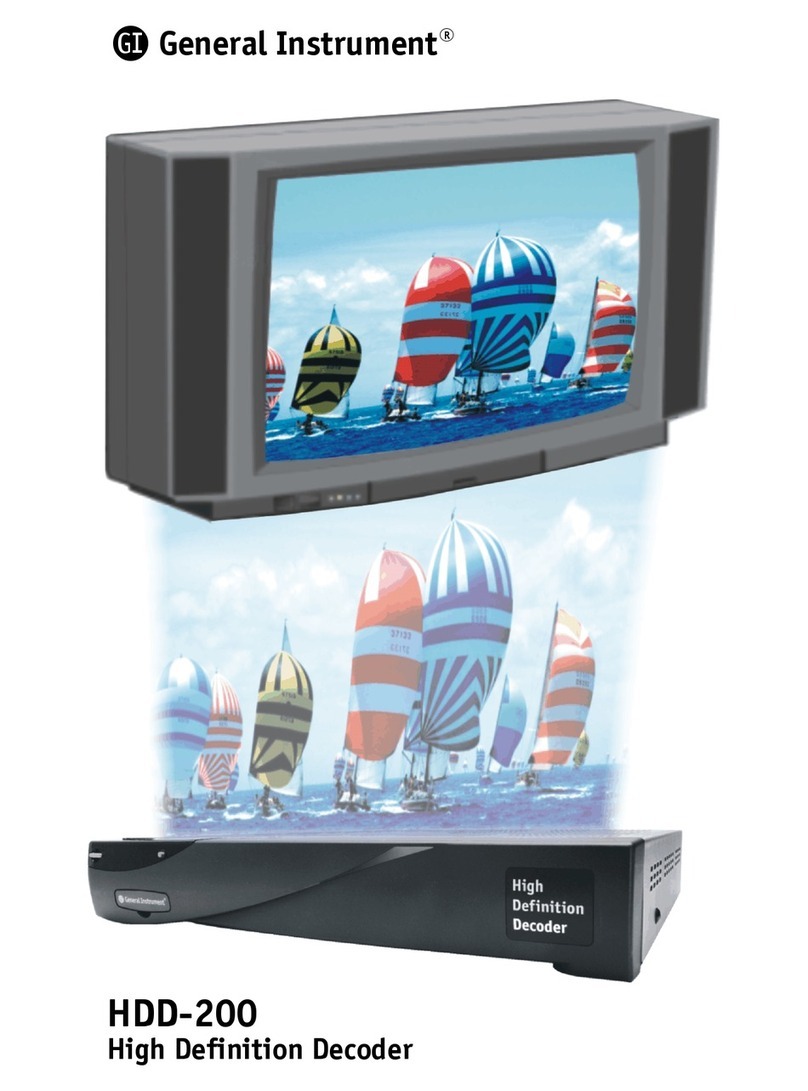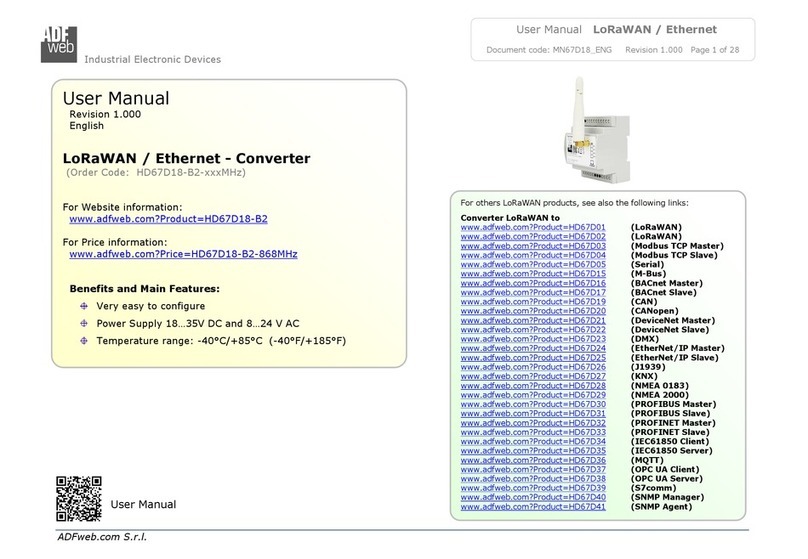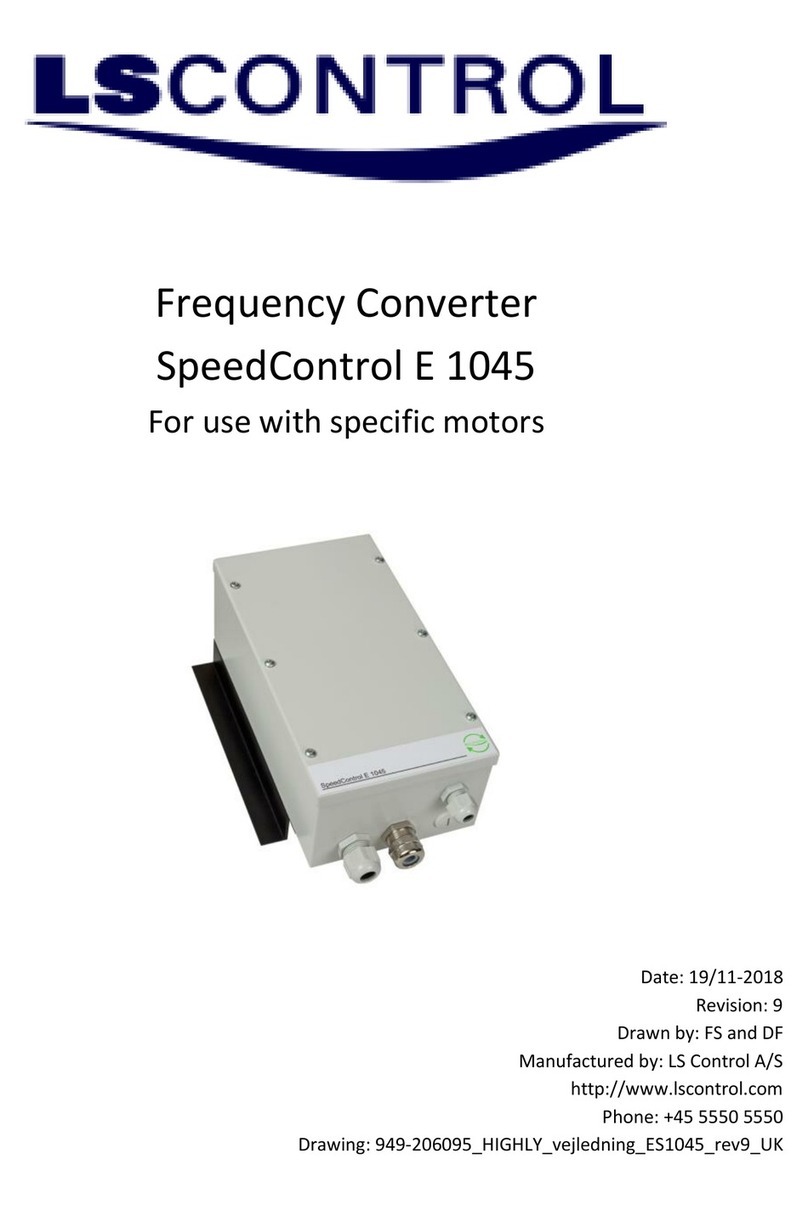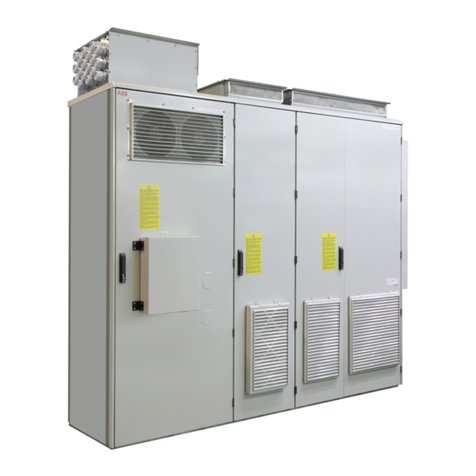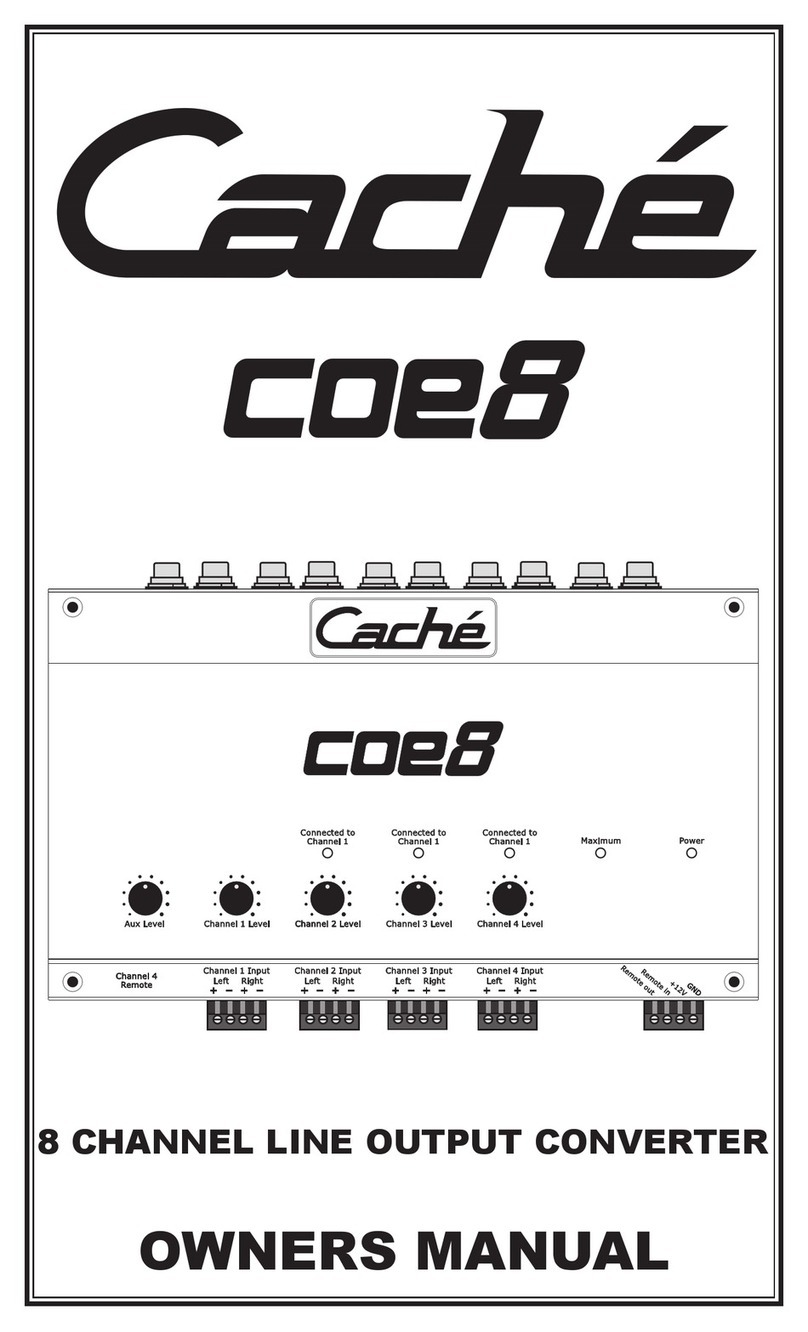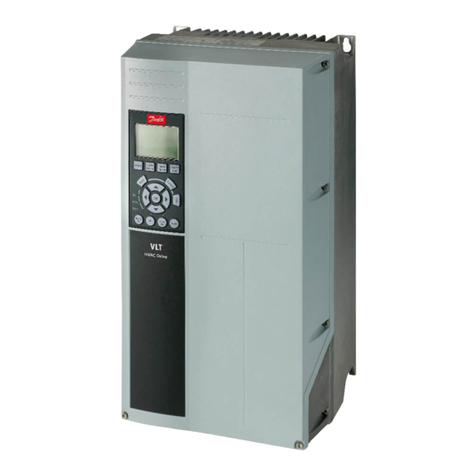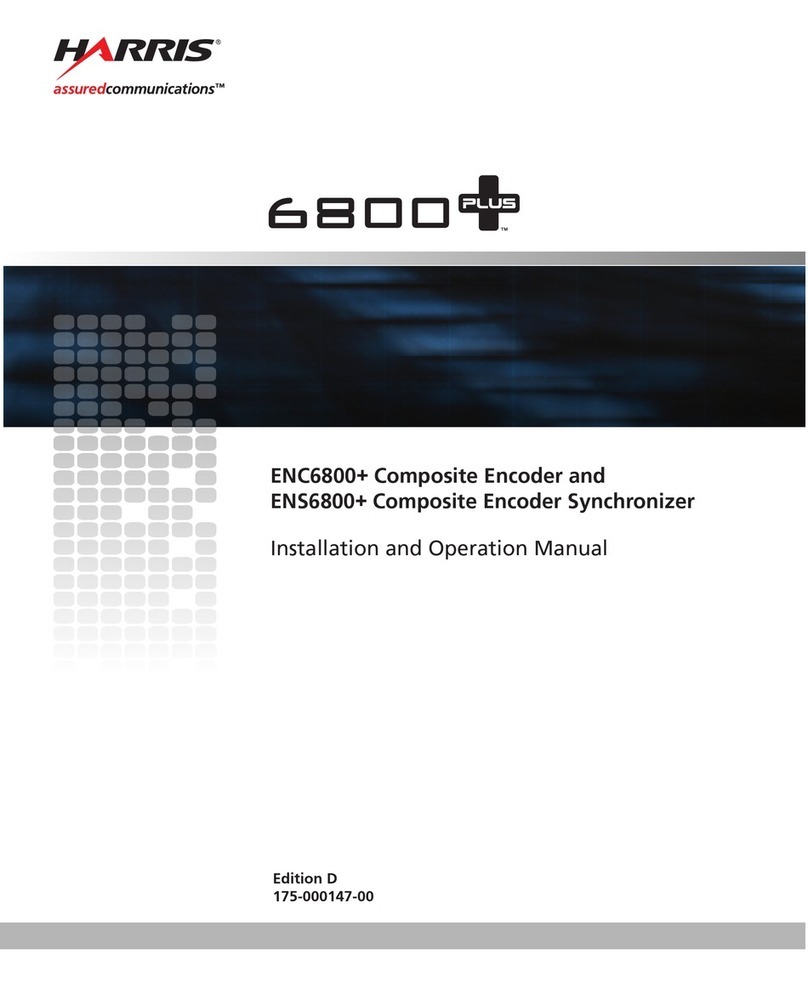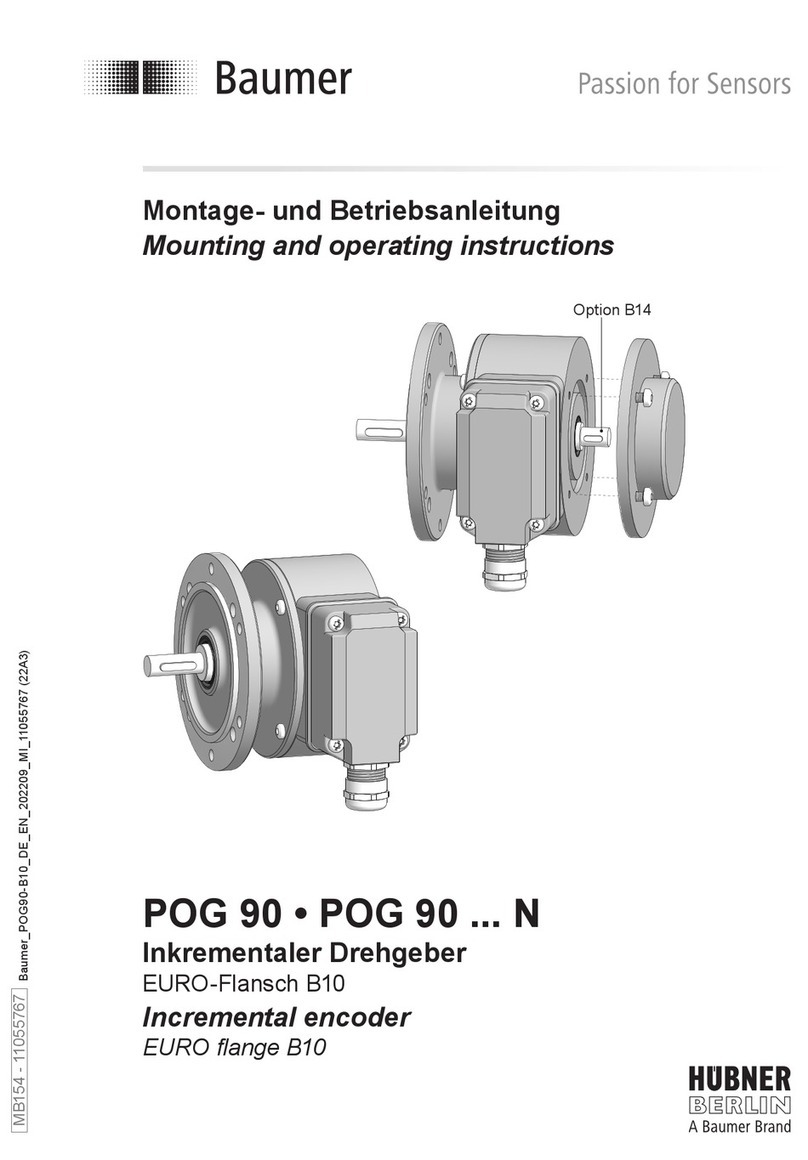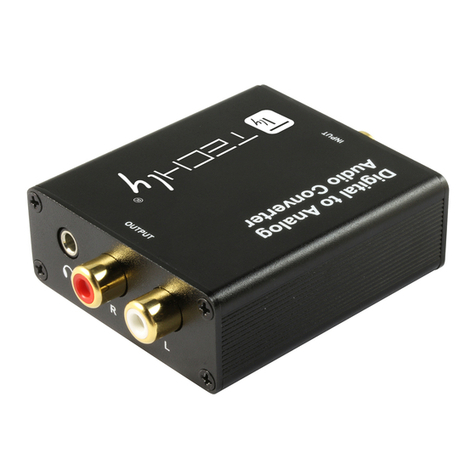General Instrument DSR-4800 Series User manual

Manufactured under license from Dolby Laboratories Licensing Corporation.
The ‘Double-D’ symbol is a trademark of Dolby Laboratories.
This product contains one or more programs protected under international and U.S. copyright laws as unpublished
works. They are confidential and proprietary to Dolby Laboratories Licensing Corporation. Their reproduction or
disclosure, in whole or in part, or the production of derivative works therefrom without the express permission of
Dolby Laboratories Licensing Corporation is prohibited. Copyright 1992–1996 by Dolby Laboratories, Inc. All
rights reserved.
This unit may be used for the decoding of DigiCipher®II television signals, but only if the receipt of
DigiCipher®II television signals has been authorized by relevant program providers.
DigiCipher®is a registered trademark of General Instrument Corporation.
Portions of this product are manufactured and sold under license from General Instrument Corporation for U.S.
Patent Nos. 4,613,901, 4,634,808, 4,712,238, 4,792,973, 4,864,615, 4,933,898, 5,144,664, 5,606,616, 5,485,577,
5,081,680, 4,975,951, 5,083,293, 5,111,504, 5,671,276 and other patents issued or pending.
© 1996–1999 General Instrument Corporation. All rights reserved.
The unauthorized modification, sale or use of any Access Control and Encryption module (ACE) contained herein is
prohibited
by law. Any such modification or alteration of this product or any unauthorized reception of television programming
could
subject the user and/or party modifying the ACE to fines, imprisonment and civil damages.

Safety Considerations
ii
SAFETY CONSIDERATIONS
CAUTION
RISK OF ELECTRICAL SHOCK
DoNotOpen
AVIS – RISQUE DE CHOC ELECTRIQUE
Ne Pas Ouvrir
This symbol means that dangerous voltages are present within the equipment. These
voltages are not insulated and may be of sufficient strength to cause serious bodily
injury if touched. This symbol may also appear on schematics.
This symbol calls attention to a critical procedure or means that refer you to the
instruction manual for operating or service information. Only qualified service
personnel are to install or service the equipment. This symbol may also appear in text
and on schematics.
WARNING:
To reduce the risk of fire or electrical shock, do not expose this equipment to rain or
moisture.
To prevent electrical shock, do not use the receiver electrical power plug (polarized with
an extension cord, receptacle or other outlet) unless the blades can be fully inserted to
prevent blade exposure.
The unauthorized modification of any decoder and the sale and use of any such decoder
is prohibited by law. Any such modification or alteration of this product or any
unauthorized reception of television programming could subject the user and/or seller
and/or party modifying the decoder to fines, imprisonment and civil damages.
CAUTION:
To reduce the risk of electrical shock, do not remove cover. Refer servicing to qualified
service personnel. This installation should be made by a qualified service person.
ATTENTION: This commercial unit is intended for the decoding of DigiCipher®II television signals for
commercial use. Possession of this device does not enable or entitle the possessor to
receive DigiCipher
®
II television signals. Contact program providers to obtain
appropriate authorizations.

Safety Considerations
iii
NOTE: This equipment has been tested and found to comply with the limits for a Class A digital device,
pursuant to Part 15 of the FCC Rules. These limits are designed to provide reasonable protection against
harmful interference when the equipment is operated in a commercial environment. This equipment
generates, uses and can radiate radio frequency energy and, if not installed and used in accordance with
the instruction manual, may cause harmful interference to radio communications. Operation of this
equipment in a residential area is likely to cause harmful interference in which case the user will be
required to correct the interference at his own expense. This digital apparatus does not exceed the Class A
limits of radio noise emissions from digital apparatus set out in the Radio Interference Regulations of the
Canadian Department of Communications.
MULTIPLEVOLTAGEEQUIPMENT:
The power cord included with your unit is for use with standard 125V AC supplies. If it is necessary to
operate the product in the U.S.A. with a 220V AC supply, then a UL-Listed power cord must be used and
the internal power supply jumper must be set. For countries outside the U.S.A. it is required to use a
power cord that complies with the electrical standards established by that country.
See IMPORTANT SAFEGUARDS for additional safety instructions.

Important Safeguards
v
IMPORTANT SAFEGUARDS
1. Read These Instructions First:
Read all safety and operating instructions before
installing or operating this equipment.
2. Retain This Instruction Manual:
Retain safety and operating instructions for
future reference.
3. Heed Warnings:
Adhere to all warnings on the equipment and in
this manual.
4. Follow Instructions:
Follow all operating and use instructions.
5. Cleaning:
Unplug the equipment from the AC power
source before cleaning.
DO NOT use liquid or aerosol cleaners.
6. Attachments:
ONLY use manufacturer recommended
attachments. Use of other attachments may cause
a hazard.
7. Water and Moisture:
DO NOT operate the equipment in high-
humidity areas.
8. Accessories and Location:
DO NOT place this product on an unstable cart,
stand, tripod, bracket or table. The product may
fall causing serious injury and serious damage to
the product. Use only with a cart, stand, tripod,
bracket or table that is recommended by the
manufacturer or sold with the product. Any
mounting of the product should follow the
manufacture’s instructions and should use a
mounting accessory recommended by the
manufacturer.
9. Ventilation:
DO NOT block or obstruct slots or openings in
the equipment chassis. These openings provide
ventilation, ensure reliable operation of the
equipment and protect it from overheating.
10. Environment:
NEVER place this equipment near or over a
radiator or heat register.
DO NOT operate this equipment in an area
where proper ventilation is not provided.
11. Power Sources:
ONLY operate this product from the type of
power sources indicated in this manual or on the
appropriate marking label.
12. Grounding or Polarization:
This product may be equipped with a polarized
AC line plug (i.e., a plug having one blade wider
than the other). This plug will fit into the power
outlet only one way. If you are unable to fully
insert the plug into the outlet, try reversing the
plug. If the plug should still fail to fit, contact an
electrician to replace the obsolete outlet. This is
a safety feature, DO NOT attempt to defeat the
purpose of this safety feature.
13. Power Cord Protection:
Route power cords so that they are not likely to
be walked on or pinched by items placed on or
against them. Pay particular attention to cords at
plugs, outlets and the point where they exit from
the product.
14. Outdoor Antenna Grounding:
If an outside antenna or cable system is to be
connected to the product, be sure the antenna or
cable system is grounded as to provide some
protection against voltage surges and build-up
static charges.

Safety Considerations
vi
Section 810 of the National Electrical Code,
ANSI/NFPA No. 70 provides information with
respect to proper grounding of the lead-in wire
to an antenna discharge unit, size of grounding
conductor, location of antenna discharge unit,
connection to grounding electrodes and
requirements to grounding electrodes.
15. Lightning:
For added protection for this product during a
lightning storm, or when the product is left
unattended and unused for long periods of time,
unplug the product from the wall outlet and
disconnect the antenna or cable system. This will
prevent damage to the video product due to
lightning and power line surges.
16. Power Lines:
DO NOT locate the outside antenna in the
vicinity of overhead power lines, or where it can
fall into such power lines or circuits. When
installing an outside antenna system, take
EXTREME CARE to keep from touching such
power lines or circuits as contact with them may
be fatal.
17. Overloading:
DO NOT overload wall outlets or extension
cords as this can result in fire or electrical
shock.
18. Object and Liquid Entry:
NEVER push objects of any kind into the slots
or openings of this product. Objects may be
exposed to dangerous voltage points. This may
also short out parts and may result in fire or
electrical shock.
DO NOT pour liquid of any kind into the slots or
opening of this product.
19. Servicing:
DO NOT attempt to service or repair this
product yourself. There are no user serviceable
parts in this product. Opening or removing the
chassis covers may expose you to dangerous
voltages. Refer all servicing to qualified
technical personnel.
20. Damage Requiring Repair:
§When the power supply cord or plug is
damaged.
§If the product has been exposed to water or
rain.
§If liquid of any kind has been spilled, or
objects of any kind have fallen into the
product.
§If the product does not perform normally by
following the operating instructions.
–Adjust only those controls that are
covered in this Operating Manual. An
improper adjustment of other controls
may result in damage or misalignment,
often requiring extensive corrective
action by a qualified technician.
§If the product has been dropped or the
chassis has been damaged.
§If the equipment exhibits a distinct change in
performance. (This may indicate a need for
service.)
21. Replacement Parts:
When replacement parts are required, make sure
the qualified technician uses only those parts
recommended by the manufacturer.
Unauthorized use of parts or substitutions may
result in fire, electrical shock or improper
operation of the product.
22. Safety Check:
Upon completion of any service or repair to the
product, ask the qualified technician to perform
safety checks to ensure the product is in proper
working condition.
23. Note to System Integrators:
This reminder is provided to call the system
integrator’s attention to Article 820-40 of the
NEC. This article provides guidelines for proper
grounding and, in particular, specifies that cable
ground shall be connected to the grounding
system of the building, as close as possible to the
point of cable entry as practical.


Table Of Contents
vii
TABLE OF CONTENTS
SAFETY CONSIDERATIONS II
IMPORTANT SAFEGUARDS V
TABLE OF CONTENTS VII
CHAPTER 1
INTRODUCTION................................................................................................................................................ 1
WHAT ARE VIRTUAL CHANNELS?.............................................................................................................. 1
CHAPTER 2
THE DSR-4800 SERIES......................................................................................................................................2
THE DSR-4800.................................................................................................................................................. 3
THE DSR-4810.................................................................................................................................................. 4
THE DSR-4850.................................................................................................................................................. 5
CHAPTER 3
SPECIFICATIONS..............................................................................................................................................6
DSR-4800.......................................................................................................................................................... 6
CHAPTER 4
INVENTORY AND INSTALLATION................................................................................................................ 9
INVENTORY.................................................................................................................................................... 9
MOUNTING...................................................................................................................................................... 9
POSITIONING.................................................................................................................................................. 9
CHAPTER 5
FRONT PANEL CONTROLS AND MENU DISPLAY ................................................................................... 11
FRONT PANEL............................................................................................................................................... 11
EDITING AND MENU CONFIGURATION.................................................................................................... 14
TO EDIT MENU INFORMATION: ............................................................................................................ 14
NAVIGATING THE MENU DISPLAY........................................................................................................... 14
STATUS MENU:........................................................................................................................................ 15
PROGRAMS MENU:................................................................................................................................. 15
PRESETS MENU:...................................................................................................................................... 19
RF MENU:................................................................................................................................................ 19
VIDEO MENU: ......................................................................................................................................... 22
AUDIO MENU:......................................................................................................................................... 23
REMOTE MENU:...................................................................................................................................... 25
TIMERS MENU:........................................................................................................................................ 26
DATA MENU: ........................................................................................................................................... 26
CONFIG MENU:....................................................................................................................................... 27
ALARMS MENU:....................................................................................................................................... 31
SAVE MENU:............................................................................................................................................ 32
CHAPTER 6
REAR PANEL AND CONNECTORS............................................................................................................... 33

Table Of Contents
viii
REAR PANEL................................................................................................................................................. 33
CONNECTING THE CONNECTORS............................................................................................................. 36
AC POWER INPUT................................................................................................................................... 36
EIA 232 ASYNC DATA .............................................................................................................................. 36
EIA 232/485 LOG/REMOTE...................................................................................................................... 36
#1 & #2 DIGITAL AUDIO........................................................................................................................ 36
#1 - #4 RF INPUT...................................................................................................................................... 36
ETHERNET............................................................................................................................................... 37
ASI OUTPUT............................................................................................................................................. 37
4:2:2 SDI................................................................................................................................................... 37
TERMINAL STRIP..................................................................................................................................... 37
CHAPTER 7
LANGUAGE ABBREVIATIONS ..................................................................................................................... 38
CHAPTER 8
PRODUCT SUPPORT & EQUIPMENT RETURNS....................................................................................... 39
IF YOU NEED HELP...................................................................................................................................... 39
REPAIRING PROCEDURES: ......................................................................................................................... 39
WARRANTY..................................................................................................................................................... 40

Introduction
1DSR-4800 Operating Manual
CHAPTER 1
INTRODUCTION
General Instrument DSR-4800 digital satellite receivers are integrated
receiver/decoders (IRD) designed for broadcast networks, cable systems and
other commercial satellite operations. They are simple to use as they allow the
program provider to perform many of the complex setup tasks. The receivers can
then receive these instructions from the satellite as part of the downloaded digital
signal. They can be configured to your exact needs using the front panel menus.
WHAT ARE VIRTUAL CHANNELS?
It is important to understand how virtual channels work before using the
front panel menus.
When you manually tune to a transponder and select a programmer’s VCT
number and channel designation, the receiver will download the VCTs
available on that transponder. For example, a programmer may have one
VCT for his consumer network and a different VCT for his commercial
customers. You can accept several VCTs in memory. When you download
more tables, the table that is not used for the longest period of time is
discarded first. The number of VCTs retained depends upon table size, but
there is typically room for five or more commercial network tables.
The DigiCipher®II network and its VCT can be limited to part of one
transponder, one entire transponder, many transponders on one satellite or
many transponders on several satellites. The units have four antenna satellite
input ports that can connect to antennas aimed at two different satellites.
Since the VCTs include satellite and transponder (frequency) information,
the receiver will change satellite and transponder as needed when the virtual
channel on the front panel is changed. The receiver will give an error
message on the front panel LCD if the VCTs prompt it to change to a
satellite/transponder that it cannot find on the input ports.
At most, each virtual channel has only one video data stream. Some virtual
channels have audio or data-only services. The virtual channel may have
many audio elements, and they are selected by language: English (stereo
implied) and French-Portuguese (mono-mono) are just a sample of the 256
possibilities. The IRDs have enough memory to accept a download of 64
languages in a network. In the case of mono-mono (French-Portuguese for
example), the left output is the first mono (French), and the right output is the
second mono (Portuguese). If you specify a language that is not available, the
audio defaults to the first in the VCT list–usually selected by the programmer
because it matches the video lip movements.

The DSR-4800 Series
DSR-4800 Operating Manual 2
CHAPTER 2
THE DSR-4800 SERIES
The General Instrument DSR-4800 series of digital satellite receivers
includes the DSR-4800, DSR-4810 and the DSR-4850. The aforementioned
products are hereinafter referred to as “unit.”
DSR integrated receiver/decoders are designed for broadcasters and other
professional, contribution-quality commercial satellite operations. They can
be very simple to use as they allow the program provider to perform many of
the complex setup tasks. The receivers can receive instructions from the
satellite as part of the downloaded digital signal, or you can configure it to
your exact needs using the extensive front panel menus.
All units contain the following key features:
,The microprocessors and memory built into each unit decodes and
decompresses the MPEG-2 video, audio, data and other information in
the signal. This significantly decreases the amount of information to be
transmitted thereby reducing bandwidth requirements. Broadcasters and
programmers can transmit on one carrier any number of channels,
limited only by the material transmitted and their particular network
needs.
,Delivery of the best possible video and audio quality by using forward
error correction (FEC) techniques that make allowances for poor signal
quality. FEC determines which information is corrupted, then corrects it.
As a result, the digital signal remains clear until the signal quality
degrades to a level where FEC can no longer restore the information.
This threshold is below an analog receivers’ ability to provide
recognizable video.
,Based on MPEG-2 standards, we use virtual channel mapping to select
the desired video, audio and other data streams out of the overall
transmission.
,Virtual channel information can be determined over the satellite at any
time, allowing for dynamic changes in the network without requiring you
to reconfigure the receiver.
,Automatically handles fixed, limited-statistical and full-statistical
multiplexing to provide the best video performance.
,For audio compression, we use the Dolby®Digital compression
techniques chosen by the North American Grand Alliance for High
Definition Television and for the newest digital videodisk systems. The

The DSR-4800 Series
3DSR-4800 Operating Manual
receiver automatically adjusts to the compression rate used for the audio.
In the DVB mode, the unit is capable of processing DVB Musicam
audio.
,Non-volatile memory to indefinitely recall the operating configuration
when power fluctuates, is interrupted or removed altogether.
,Security features, including General Instrument’s proven security
system. Even though the unit does not require a TvPass™ Card to
operate with security, in the unlikely event that the code is compromised,
security can be renewed by simply inserting a card with a new code into
the receiver.
,A low profile, single rack unit design – only 1.75” EIA rack space.
,Able to process and provide the broadcast engineer with a 4:2:2 Studio
Profile @ Main Level digital video output from a DigiCipher®II or DVB
signal.
,The front panel display and edit/select control are formatted to provide
optimum resolution, execution and the most effective display of
information necessary for operation.
,Controllable or status monitored via either of two separate data interfaces
or by way of satellite network control.
,The unit’s EIA232/485 rear panel control interface can be configured to
directly plug and play with your existing network control system.
,A complete set of extended commands allow for remote control of all the
receiver’s additional controls and functions.
,Ability for network monitoring and control via a 10Base-T Ethernet
connection.
,All units offer output of ASI, digital video (i.e., SMPTE259 with
embedded four-channel audio), digital audio, analog video, analog audio,
VBI lines and closed caption.
THE DSR-4800
The General Instrument DSR-4800 receives both HD and SD signals. Both
HD and SD streams are reprocessed to the Digital Video Broadcast
Asynchronous Serial Interface format at 270 Mbps. The ASI signal is output
through a BNC connector.
SD transport streams can be processed at 4:2:2 P/ML and 4:2:0 MP/ML
decompression.
The unit receives QPSK modulated signals at L-band frequencies of 950 to
2150 MHz through one of four input ports.

The DSR-4800 Series
DSR-4800 Operating Manual 4
The DSR-4800 performs demodulation and FEC decoding of all standard
DigiCipher®II symbol and convolutional coding rates, at information rates
up to 40.46 Mbps. It also performs demodulation and FEC decoding of all
standard DVB convolutional coding rates, at information rates of 3.25–45
Msps. Within the resulting transport stream, a single DigiCipher®II service
designated by the user can be decrypted.
The DSR-4800 will automatically tune to of four L-band inputs based on the
Virtual Channel Tables sent from the UCS. The unit will use the Virtual
Channel Tables for tuning between services.
THE DSR-4801
The General Instrument DSR-4801 is a more economical version of the full-
featured DSR-4800 designed for the studio monitoring, video processing and
satellite turnaround markets requiring 4:2:2 digital video output.
DSR-4801 receives both HD and SD signals. SD transport streams can be
processed at 4:2:2 P/ML and 4:2:0 MP/ML decompression.
The unit receives QPSK modulated signals at L-band frequencies of 950 to
2150 MHz through one of four input ports.
The DSR-4801 performs demodulation and FEC decoding of all standard
DigiCipher®II symbol and convolutional coding rates, at information rates
up to 40.46 Mbps. It also performs demodulation and FEC decoding of all
standard DVB convolutional coding rates, at information rates of 3.25–45
Mbps. Within the resulting transport stream, a single DigiCipher®II service
designated by the user can be decrypted.
The DSR-4801 will automatically tune to of four L-band inputs based on the
Virtual Channel Tables sent from the UCS. The unit will use the Virtual
Channel Tables for tuning between services.
The lack of a full-feature VBI board, ASI output and Ethernet control
distinguishes it from the DSR-4850.
THE DSR-4810
The General Instrument DSR-4810 includes all features of the DSR-4800
with the addition of video synchronization capability across multiple DSR-
4810 units. The unit will accept a primary and secondary video input
reference and synchronize the output audio and video to one of those
references. It will also provide a video output reference for other units to use
as a synchronization reference.

The DSR-4800 Series
5DSR-4800 Operating Manual
THE DSR-4850
The General Instrument DSR-4850 includes all features of the DSR-4800
with the following variance: An ASI input option has been installed in place
of the satellite QPSK tuner allowing the DSR-4850 to function as a decoder.
The DSR-4850 receives the MPEG-2 transport stream in DVB ASI format
through a BNC connector to an ASI input module. Once the ASI transport
stream is received either from a DSR-4800 or DSR-4810 unit, multiple DSR-
4850 units can be looped together.
DCII HD transport streams are processed to decrypt a service selected by the
user. The resulting transport stream is output in ASI format.
SD transport streams are processed to extract, decrypt and decompress a
service selected by the user.
The DSR-4850 will use the Virtual Channel Tables from the UCS for tuning
between common services.

Specifications
DSR-4800 Operating Manual 6
CHAPTER 3
SPECIFICATIONS
DSR-4800
Mechanical
Height: 1.75” (44 mm) EIA Rack Space
Width: 19” (480 mm) EIA Rack Unit
Depth: 20” (503 mm)
Weight (estimate): 15 lbs
Power
Primary Input: 86/260V AC (switchable)
Line Frequency: 50/60 Hz
Power Consumption: 70 W (estimate)
Environmental
Humidity Range (non-condensing): 0 to 90%
Temperature Range (operational): 0 to +40° C
Temperature Range (survivable): -20 to +50° C
Rack Spacing: 1.75” (44 mm) above and below the unit
Altitude: 0 - 8000 Feet
Input Configuration
QPSK Demodulator (DCII & DVB)
Input Signal: 3.25 to 40.5 Msps
Input Frequency Range: 950 to 2150 MHz
Tuning Steps: 125 kHz
Input Level: -25 to –65 dBm
FEC Operating Modes: 5/11, 1/2, 3/5, 2/3, 3/4, 4/5, 5/6, 7/8
ASI MPEG-2 Output
Transport Stream Output: Asynchronous Serial Interface (ASI)
Data Format: Continuous
Data Rate: 270 Mbit/sec
Output Level: 1.0 vp-p +0 –200mV
Output Cable Line Drive: 400 ft RG6
ASI MPEG-2 Input (DSR-4850)
Format: ASI
Transmission: 270 MBit/Sec, both data packet and data burst
Standard: CENELEC EN 50083-9
Analog Audio (Baseband Dolby AC3 Output)
Output Impedance (differential pair with ground): 60 ohms
Total Harmonic Distortion (into 600 Ohms load): <0.5% at 1 kHz
L/R Gain In-Balance: <0.2 dB

Specifications
7DSR-4800 Operating Manual
Output Signal to Noise Ratio (A weighted): >86 dB
Sampling Rates: 44.1 and 48.0 kbps
Dolby Compression Rates: 32 to 640 kbps
Digital Audio
Output Impedance (differential pair with ground): 110 ohms
Output Level (non adjustable): Unity Gain
Total Harmonic Distortion: <0.2% at 1 kHz
L/R Gain In-Balance: <0.5 dB
Output Signal to Noise Ratio (A weighted): >90 dB
Crosstalk all Channels: -80 dB
Analog Video DC-II Mode
Output Level: +/- 2% / 1.0VP-P
Frequency Response (30Hz to 4.2MHz): 0.5 dB
Luminance Nonlinear Distortion: 3%
Video/Audio Delay: 5 nsec
Chroma Nonlinear Gain: 3%
Chroma Nonlinear Phase: 3%
Differential Gain (10% to 90% APL): 1%
Differential Phase (10% to 90% APL): 1 degree
C/L Gain Inequality: 3.0%
C/L Intermodulation: 3.0%
Luminance SNR (Unified Wgt): >58
Field Time Distortion: 3.0%
Line Time Distortion: 3.0%
VBI: CC & GI Provided Lines
4:2:0 Video Resolutions: 704, 528, 353, 720 544x480
4:2:2 Video Bit Rates: 1 to 20 Mbit
4:2:0 Video Bit Rates: 1 to 15 Mbit
4:2:2 Video Resolutions: 720, 544x480 and 720x512
Film Mode: On/Off
Copy Protection: On/Off
Analog Video DC-II Mode (continued)
Motion Prediction: Field and Dual Frame
B Frame Support: 2 and No B Frames
Digital Video
SMPTE259 Output Impedance: 75 ohm
Output Level: 800 mV (+/-50mV)
Output Jitter: <270 ps
Video/Audio Delay: +/- 5 msec
Embedded Audio (4 channel): ½ and ¾
4:2:0 Video Resolutions: 704, 528, 353, 720 544x480
4:2:2 Video Bit Rates: 1 to 20 Mbit
4:2:0 Video Bit Rates: 1 to 15 Mbit
4:2:2 Video Resolutions: 720, 544x480 and 720x512
Film Mode: On/Off
Copy Protection: On/Off

Specifications
DSR-4800 Operating Manual 8
Motion Prediction: Field and Dual Frame
B Frame Support: 2 and No B Frames
Data Interfaces
Asynchronous Data Output: RS 232 9.6 to 19.2 kbps
Remote Control: RS 232/485 9.6 to 38.4 kbps
Ethernet: 10Base-T TCP/IP, SNMP

Inventory and Installation
9DSR-4800 Operating Manual
CHAPTER 4
INVENTORY AND INSTALLATION
To prevent damage and/or safety hazards, always handle the General
Instruments DSR unit with care and only according to instructions as laid out
in this Operations Manual.
INVENTORY
The shipping carton should contain the following items:
1. A DSR unit
2. A power cord
3. A set of decorative ear/screw covers
4. One (1) Allen wrench
5. Four (4) Allen screws
6. Two (2) Phoenix connectors (audio)
7. A Warranty Information Card
8. This Operations Manual
9. Other pertinent documentation and additional manual inserts
MOUNTING
The unit is designed for installation in a EIA standard 19-inch (480 mm)
equipment rack. When mounting it in the rack, use pan or round head screws
and washers in all four front panel mounting locations. This ensures a secure
mount for the size and weight of the unit. You must supply screws matching
your rack.
POSITIONING
,To prolong service life, pay special attention that the environment in
which the DSR unit is being used is free of dust and other airborne
particles.
,Make sure the DSR unit is operated in a temperature-controlled
environment. Never place a DSR unit near a heat source.
,Allow a 1.75-inch (44 mm) air gap above and below receivers for
cooling purposes, or alternate receivers with low-power consumption

Inventory and Installation
DSR-4800 Operating Manual 10
equipment that does not block the top-to-bottom air flow of the receiver
chassis. Never install multiple units in such a way that the air intake from
one unit aligns with the outlet of another.
,Do not install a DSR unit in areas of high humidity or where there is any
danger of water infiltration.
,Do not run AC power cables and signal leads in the same duct so as to
avoid magnetic interference from the high-voltage cable.

Front Panel Controls and Menu Display
11 DSR-4800 Operating Manual
CHAPTER 5
FRONT PANEL CONTROLS AND MENU DISPLAY
FRONT PANEL
NOTE: Some information in this chapter is currently under development. As
such, it may not be properly reflected or else not included yet. Once the
information is finalized this document will be modified accordingly.
All operations described in this chapter require using the front panel, which
includes Manufacturer, Model Designation, Menu Controls, Operational
Status, Display and Edit Control.
Figure 5-1
The Front Panel
Table 5-2
The Front Panel
Key Control Type Description
1Company Designation Label Indicates Manufacturer or OEM Supplier
2Model Designation Label Indicates model name & product description
3Menu Control s Group Menu selection area
3a STATUS – Green Push Button Displays satellite and programming information, or
reverts to last saved setting if pushed while in edit mode
3b PROG – Green Push Button Selects Virtual Channel Tables from Rom Tables
3c PRESETS – Green Push Button
3d RF IN – Green Push Button Displays antenna settings and satellite data
3e VIDEO – Green Push Button Displays video format settings
5
3
(a-l)
4 (
a-h)
2
6
1
7
O
F
F
L
I
N
E
F
/
P
L
O
C
K
S
I
G
REM
O
T
E
AUTH
O
R
I
Z
E
R
F
L
O
C
K
E
D
B
E
R

Front Panel Controls and Menu Display
DSR-4800 Operating Manual 12
Key Control Type Description
3f AUDIO – Green Push Button Displays audio level and format settings
3g REMOTE – Green Push Button Displays remote control port settings
3H TIMERS – Green Push Button
3I DATA – Green Push Button Displays async data port settings and tuner data
3J CONFIG – Green Push Button Displays firmware and hardware configuration data
3K ALARMS – Red Push Button
3L SAVE – Red Push Button Saves new settings to receiver memory
4Operational Status Group Displays current operating conditions
4a Offline Illuminated Receiver is offline
4b Alarm Illuminated
4c F/P Lock Illuminated Front panel access & control is locked by the remote
controller
4d Remote Illuminated Unit is being controlled via remote
4e Authorize Illuminated
4f RF Locked Illuminated Receiver is locked to incoming signal
4g Input Signal Meter Bar Graph Indicates input signal strength
4h BER Meter Bar Graph Indicates received signal bit error rate
5Display See Chapter 6 for detailed menu operation
6Edit Control Rotary/Push
Knob Press to enable Edit function; rotate to select and change
settings
7TV Pass Card Provided renewable security interface
This manual suits for next models
3
Table of contents
Other General Instrument Media Converter manuals
Popular Media Converter manuals by other brands

Baumer
Baumer HUBNER BERLIN DeviceNet PMG 10 Installation and operating instructions
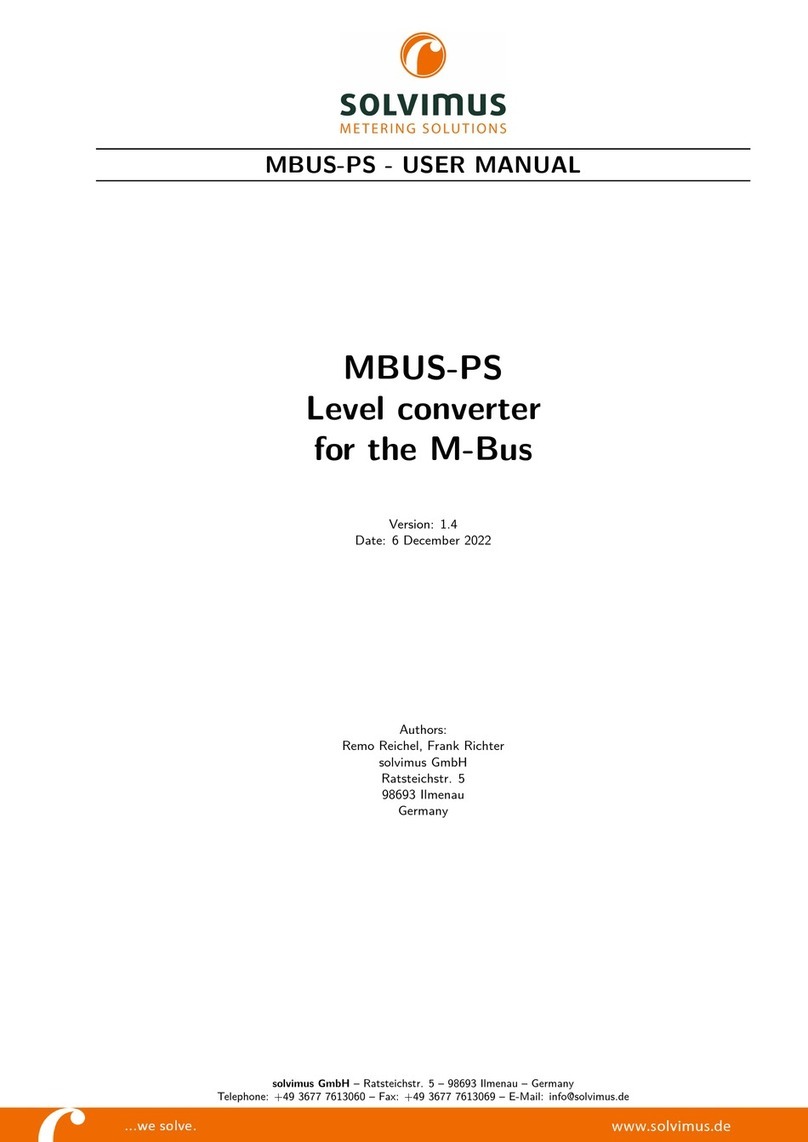
Solvimus
Solvimus MBUS-PS6 user manual

Wisi
Wisi OE 01 operating manual
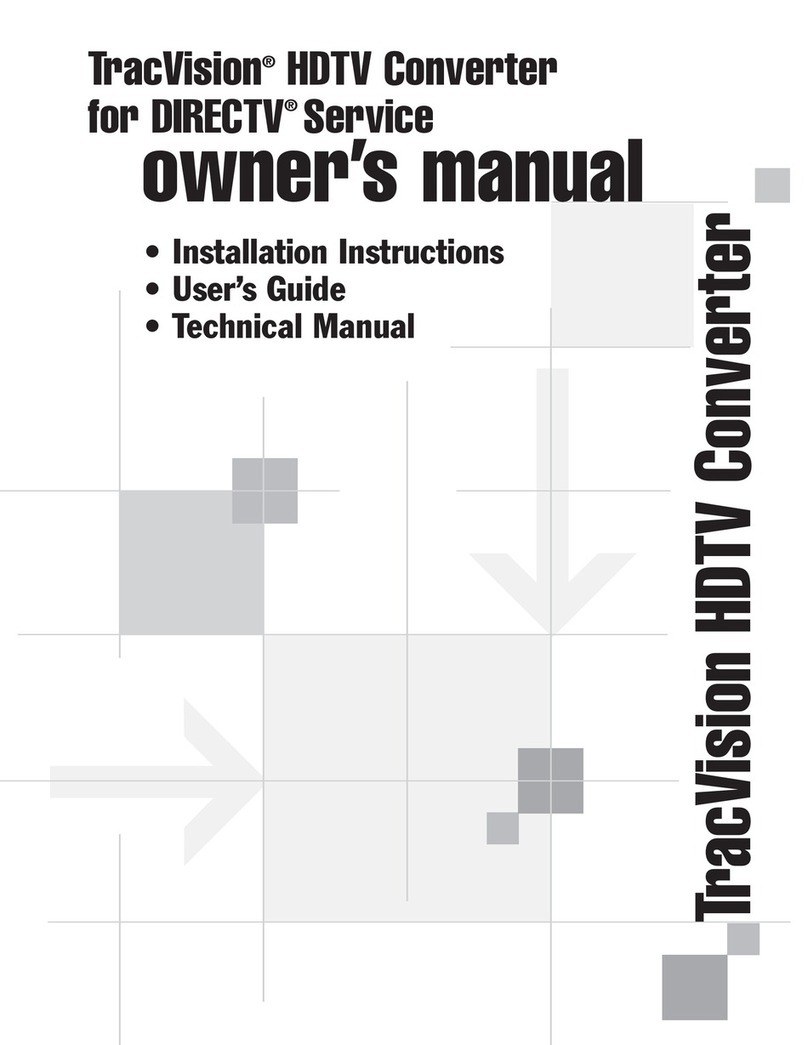
KVH Industries
KVH Industries TracVision HDTV Converter user guide
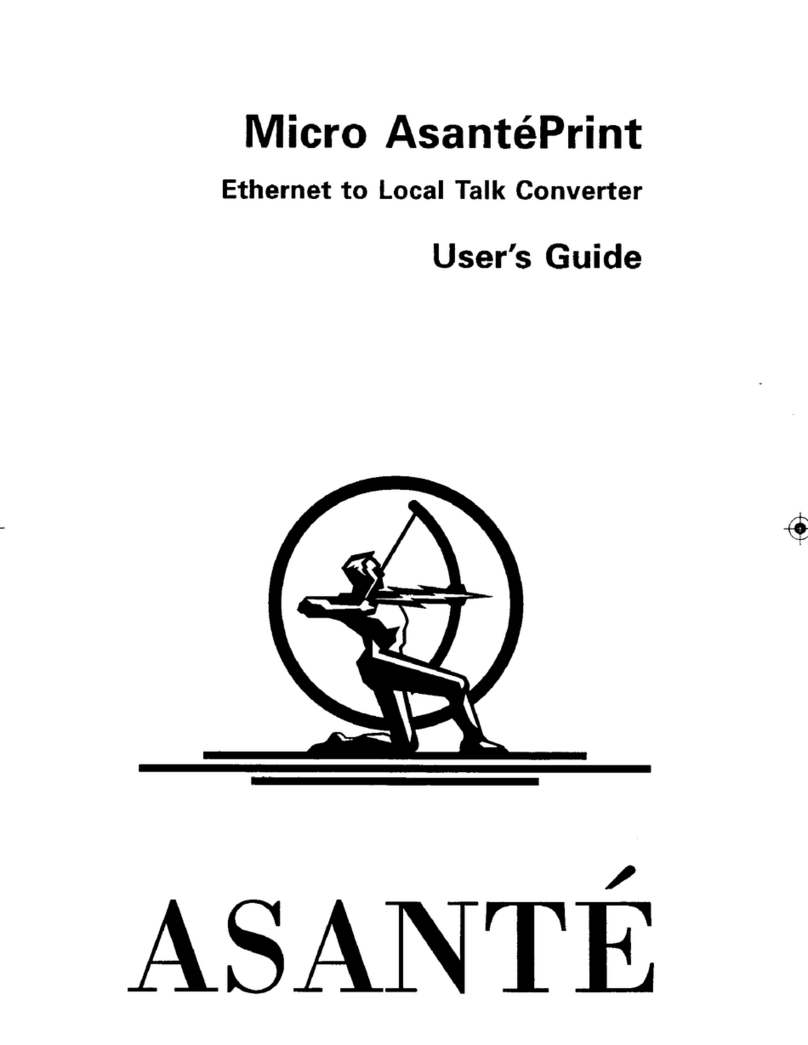
Asante
Asante Micro AsantePrint user guide
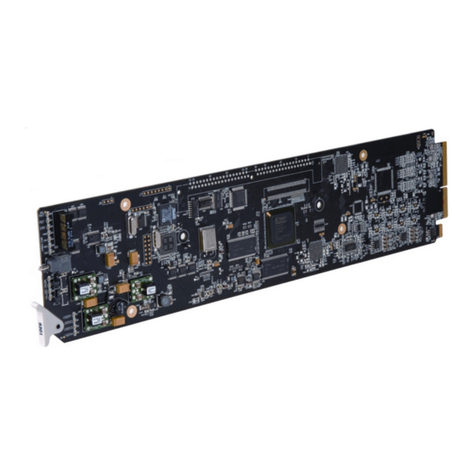
Cobalt Digital Inc
Cobalt Digital Inc 9082 product manual
